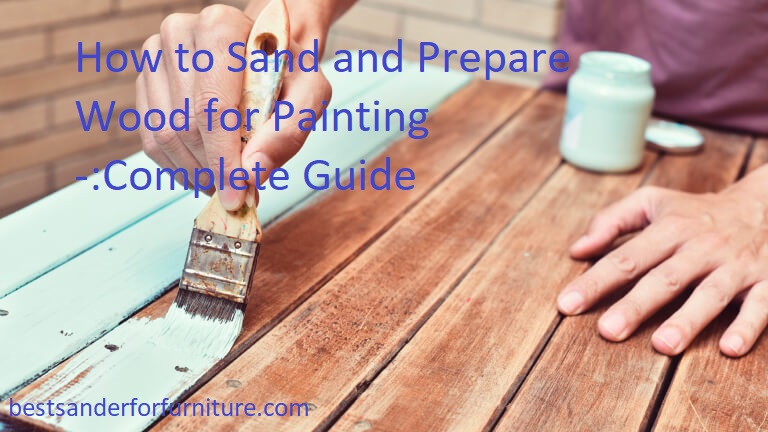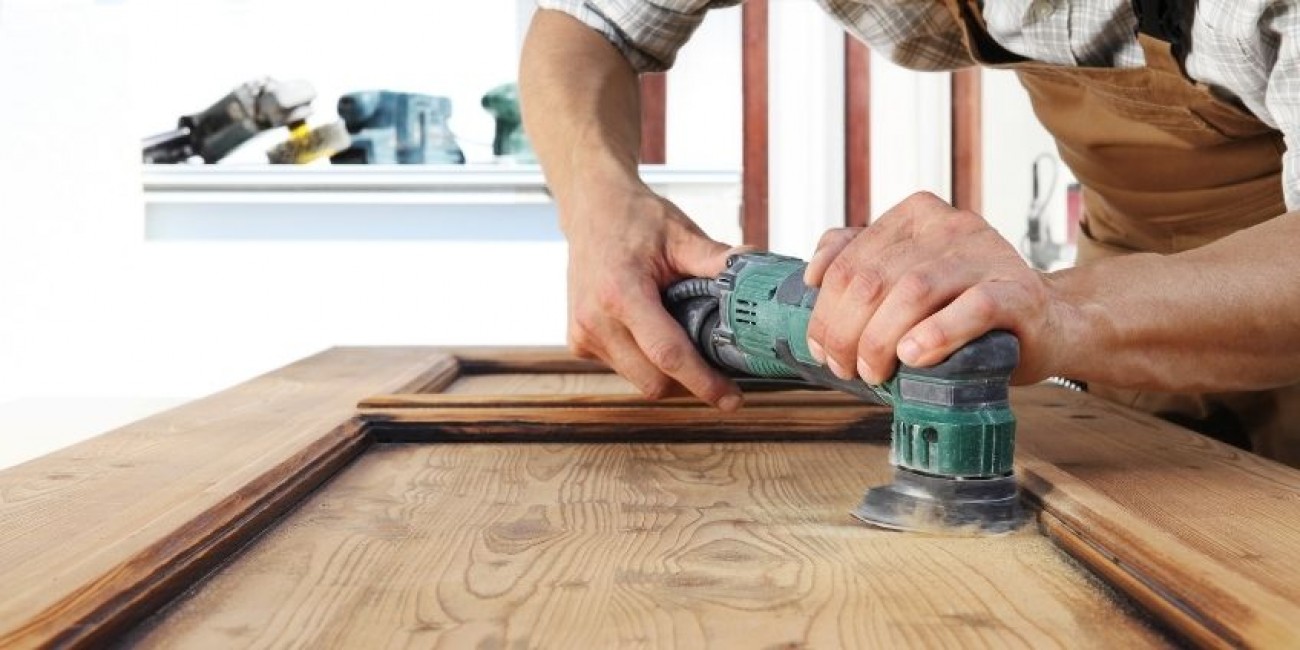Want to learn how to sand and prepare wood for painting like a pro? You’ve come to the right place!
This guide will provide you with all the tips you need to ensure your project looks perfect every time. Whether it’s a new shed or furniture, mastering these simple steps will bring an amazing finish.
Painting wood is a good way to make it look attractive and give it an updated, refreshed look. With the right preparations, you can ensure that your painting project yields excellent results.
This guide will explain the steps involved in sanding and preparing wood for painting so that you can take on the job yourself. From understanding what types of sandpaper to use and how to properly sand the wood, to understanding which primers work best, this guide aims to provide all the information necessary for a complete wood-painting project.
Assessing the Condition of the Wood
When starting any painting project, it is important to evaluate the condition of the wood that needs to be sanded and prepared for painting. The painter should inspect the wood for signs of damage such as splitting, rot, cracking, insects and weather wear. Any defects should be repaired before sanding and painting.
The next step is to determine whether you are dealing with hard or soft woods. Softwood absorbs paint more quickly than hardwoods, and if not sealed properly will not result in a smooth finish. Once you have determined the type of wood, use a flexible sanding block with medium grit paper to remove flaking paint and smooth out any uneven surfaces. Use finer grit paper to ensure an even smoother surface before moving on to primer or sealer.
If you find any cracks or splits in the wood, make sure they are filled prior to sanding so they do not interfere with the end result.
Inspecting for any damage or imperfections
Before preparing a wooden surface for painting, it is essential to inspect the wood for any damage or imperfections. Damage may be caused by water, pests, or mechanical forces and can make the painted surface look substandard or unappealing. The following steps should be taken to effectively inspect wood before painting:
- Look over the wood paneling or other wooden surface with a magnifying glass to detect any cracks, holes, knots, chips and other imperfections.
- Look at the edges of the wooden items with a flashlight to reveal faults in craftsmanship such as saw marks and splits in the edges of joints.
- Using a flat sanding block to knock down raised areas of grain in strong light will expose signs of any irregularities as well as color variations within each area of grain.
- When inspecting for insect damage such as termites it’s best to use an infrared camera to detect pest-induced hollow spots inside the wood material itself if structural beams are placed inside walls it is not uncommon for them to become infected with insects like Termites and Carpenter Ants.
- If your inspection reveals a loose board onto which termites have been attracted this should be replaced immediately as these pests can cause considerable damage while they feed on the wood material itself.
Deciding on the type and grit of sandpaper to use
When choosing the type of sandpaper to use, it is important to consider the nature of the wood in order to achieve an optimal result. Sandpaper that is too coarse can damage delicate woods, while sandpaper that is too fine will not effectively smooth out rough surfaces. Choosing the right grit size for your wood project is essential for successful preparation.
A general rule of thumb when selecting the type and grit of sandpaper is to start with a medium-grit paper, such as #120-150, which should be used if you are dealing with softwoods or if you need to achieve a large degree of flattening on hardwoods. If you’re working on hardwood projects, consider using a finer paper such as #220-240 garnet or aluminum oxide sandpaper. To remove scratches or other imperfections prior to painting, use #320-400 silicon carbide or diamond coated abrasives for best results. For one final “finesse” run prior to painting, use an ultrafine grade #600-800 sandpaper.
Understanding the direction of the wood grain
The direction of the wood grain will determine the best sanding methods and materials to use for optimum results. It’s important to understand the direction of the grain before you pick up a sander. To identify it, use your finger or a piece of chalk to draw a line across the entire piece of wood surface that you are sanding. Fieldsparks or swirls in the mark will indicate which way is up or down.
If all directions seem to be equal, then it may be that you are looking at fiber strands, and not wood grain lines. If this is so, then planing can help narrow down which direction is up and which one is down as these fibers will break in opposite directions when planing runs perpendicular to them.
Knowing how your wood grain runs will also help determine the type of sandpaper used as different kinds of paper are more suitable for sanding different types of wood based on their grain orientation.
Applying Primer
After the wood has been sanded and cleaned, it’s time to apply primer. Primer will provide a layer of protection on the wood and help the paint adhere better. It will also minimize the appearance of imperfections in the wood grain or surface.
Choose a primer that is compatible with the type of paint you are using; some primers are oil-based while others are water-based. Oil-based primers are known for giving good coverage, but they can be messy to clean up after use. Water-based primers typically dry faster than oil-based ones, making them an ideal choice for those with little time to complete their project.
Whichever product you choose, read the instructions carefully and exercise proper precautions when using any type of hazardous material; this includes wearing protective clothing, such as gloves and a face mask as well as opening windows or using proper ventilation systems when possible.
To prepare your wooden surface for painting: -Thoroughly stir your primer before applying it to make sure any settled pigment is evenly mixed in. -Carefully apply a thin coat of primer to your wood surface with a smooth brush or roller brush depending on what type you have purchased. Take care not to allow any drips or smudges to form on working surfaces – these can easily keep paint from adhering properly later on. -Follow manufacturer’s instructions regarding how long your primer needs to dry before moving onto step four – painting!

Choosing the right type of primer
Before painting wood surfaces, it’s important to choose the right type of primer to ensure optimal adhesion and finish. Primers act as a sealant, protecting the wood from moisture while also creating an ideal surface for paint to adhere to. It also ensures that your paint application looks even and smooth.
When choosing a primer, consider both the type of wood you’ll be painting and the climate where you’ll be painting. Generally speaking, you’ll want to opt for a water-based primer for most interior and exterior applications as it is easy to clean up with just soap and water. Additionally, make sure that your primer supports oil-based or latex paint — different primers are designed to support different types of topcoats.
Another factor to consider is whether you are looking for a stain-blocking primer or one that will simply act as a sealant — some primers can provide both functions. Read labels carefully before buying so that you select the right kind for your particular project. If in doubt, speak with an experienced professional at your local hardware store— they should be able to advise on what kind of products will deliver the best results given your specific needs.
Applying primer with a brush or roller
Now is the time to apply primer to the wood surface. It’s important to use a paintbrush or foam roller designed specifically for latex primers and paints. Primer is designed to seal the surface of your project and prepare it for painting, so be sure to cover all surfaces and any nooks or crannies.
Be sure that you take special care around corners, crevices, or detailed designs, as leaving primer unapplied in these spots can cause problems during the final application of paint. Brush strokes should be applied in overlapping motions while the paint is still wet so that the final product has no visible brush marks. Do your best not to overwork this coat; if necessary, some light sanding can be done afterwards to even out brushstrokes.
Allow this coat of primer to dry completely before starting on your second coat if needed; refer to manufacturer instructions for drying times.
Allowing the primer to dry
Once the primer has been applied and has dried, you may wish to sand the wood a second time, as the primer will have filled any imperfections. Be sure to use a fine-grit sandpaper or block and gently but firmly remove any high points of the primer. By doing this you will ensure that your final coat of paint adheres evenly, creating a smooth finish. If sanding is required, check details like grooves which may require hand-sanding to get into all of the crevices.
After your second sanding is complete it’s time for a final clean. Dust should be removed with either a vacuum cleaner or cloth before re-inspecting for any minor imperfections that need attending to prior to painting. Now you are ready to begin painting!
Applying Paint
Before applying paint to wood, it’s important to ensure that the surface is clean and properly sanded. Cleaning will help remove dust, dirt and other debris that may cause imperfections in the paint finish. Sanding will help create a smooth surface for the paint to adhere to, helping to minimize brush strokes and giving you a beautiful finished product.
To start painting, begin by carefully stirring the can of paint until there are no lumps or clumps remaining. Then use a high-quality brush or roller to apply an even coat of paint over the entire project. For larger pieces, multiple thinner coats are often better than one thick coat, so be sure to follow up with additional layers until you achieve an even coverage throughout.
Be sure to brush or roll in one direction at all times and feather any overlapping areas so that you avoid streaks and clumps when possible. Finishing with small brush strokes on outward sections can also help reduce any visible brush strokes as well as enhance your overall appearance of the final piece. Once completed, allow your project to dry completely before adding further layers of protection or further finishing touches if required.
Choosing the right type of paint
Knowing what type of paint is best for the job is essential in order to achieve the desired results. For any wood that will be outdoors, use a water-resistant exterior or alkyd paint, as these are specially formulated to withstand the elements.
For wood that will not be exposed to weather, you can use oil- or water-based latex paint. Before committing to a particular type of paint, check with the retailer or manufacturer for painting tips on what is most suitable.
Also determine how much paint you’ll need based on the size and number of coats required by your project. It’s important to purchase more than you think you’ll need in order to avoid having to return for extra product mid-project!
Applying paint with a brush or roller
To apply paint with a brush or roller, you’ll need to have a few supplies ready. You should have something to protect the surface you’re working on, like tarps or drop cloths. You’ll also need painter’s tape, brushes and/or rollers of your choice, as well as buckets for both primer and paint.
When you’re ready to get to work, start by measuring and cutting your painter’s tape so that it creates a crisp line along the edges of the room or space where you plan to paint. Next, prep your brushes by filling one bucket with warm soapy water and the other with warm water from the tap. Swish the brush in the bucket of soapy water and then rinse off thoroughly in the bucket filled with warm tap water. Let any excess water drip off and then dip about one third of its bristles into your chosen paint color.
Finally, use long vertical strokes across your walls when painting or short horizontal strokes if rolling is more comfortable for you. Stand back from time to time while painting to take mental notes on where else needs another coat of primer or paint — this can save time in the end!
Allowing the paint to dry
Before applying a new coat of paint, it’s important to allow the previous coat to dry properly. The best way to do this is to wait 24 hours or more and then lightly sand the wood with medium-grit sandpaper. This will help remove any bumps, air bubbles and lumps in the paint so that your final paint job looks smooth and even.
Once you have finished sanding the wood, wipe it down with a damp cloth to remove any sawdust or other small particles. Then, let the wood dry completely before adding a new layer of paint.

Conclusion
It is important to realize that wood must be sanded before painting in order to remove any dirt, sawdust, or other particles that may have accumulated on the surface. This will help create an even, smooth surface for the paint to adhere properly, yielding a more durable finish. Additionally, sanding can help seal any cracks and small imperfections in the wood which will also help protect against moisture and promote a longer lasting paint job.
In conclusion, sanding and preparing wood for painting is an important step that should not be overlooked. Learning how to correctly sand your wood surface can save you time and money in the long run by ensuring that you get a professional looking finish every time you paint your wooden surfaces. Taking the time now to ensure proper preparation will pay off later with a beautiful finished product that will last for years to come.
FAQ’S
What is the best way to sand wood before painting?
The best way to sand wood before painting is to start with a coarse grit sandpaper and progress to finer grits, making sure to remove any existing finish, dirt, or imperfections.
How sanded does wood need to be before painting?
Wood needs to be sanded enough to remove any existing finish, dirt, or imperfections, and to create a surface that will allow paint to adhere properly.
Do you sand wood before you paint it?
Yes, sanding wood before painting is important to remove any existing finish, dirt, or imperfections, and to create a surface that will allow paint to adhere properly.
How do you prepare wood surface for painting?
Preparing a wood surface for painting involves sanding the wood to remove any existing finish, dirt, or imperfections, cleaning the surface, and applying a primer to help the paint adhere properly.
Is it better to sand wood wet or dry?
It is better to sand wood dry, as wet sanding can cause the wood to swell and make it more difficult to achieve a smooth surface.
What is the proper way to sand wood?
The proper way to sand wood is to start with a coarse grit sandpaper and progress to finer grits, making sure to sand in the direction of the wood grain and to remove any existing finish, dirt, or imperfections.
What happens if you paint wood without primer?
Painting wood without primer can result in poor adhesion, uneven coverage, and a shorter lifespan of the painted surface.
What is the fastest way to sand wood?
Using a power sander, such as a belt sander or random orbital sander, can be the fastest way to sand wood, but care must be taken to avoid removing too much material.
What is the best sandpaper for wood and repaint?
The best sandpaper for wood and repaint depends on the task at hand, but medium to fine grit sandpaper, such as 120-220 grit, is often used for general sanding and paint preparation.
Which sander is best for paint preparation?
A random orbital sander or sheet sander with a medium grit sandpaper is often best for paint preparation, as they can quickly remove existing finish, dirt, or imperfections without removing too much material.
See more:
- Best hand sander 2023
- Best handheld belt sander 2023
- Best metal sander 2023
- Best orbital sander 2023
- Best oscillating sander 2023


